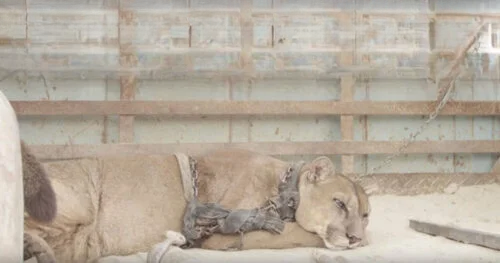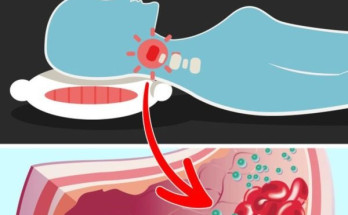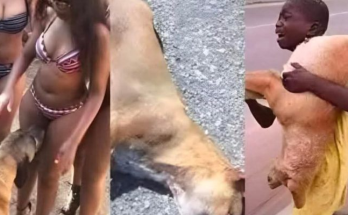Mufasa: From Circus Captivity to a Life of Dignity
When people think of a circus, images of colorful costumes, excited crowds, and performers showcasing extraordinary skills often come to mind. Children cheer, music fills the air, and the environment seems magical. The spectacle is designed to captivate and entertain. Yet, behind the bright lights and applause, a different reality often exists for the animals involved. Many live in confinement, under stress, and with little access to the freedom and natural environment they require.
For Mufasa, a mountain lion in Peru, the circus was not a place of joy or celebration but a space of long-term hardship. For two decades, he lived chained inside a worn truck, deprived of the freedom, space, and dignity that are essential to his species. The struggles he endured were largely invisible to audiences, a quiet suffering hidden behind the spectacle of performance.
Two Decades in Captivity
Mufasa’s life mirrors the experiences of many wild animals forced into entertainment. Taken from his natural habitat as a cub, he was placed in a circus environment that restricted his natural instincts. Instead of roaming freely across forests or mountains, he spent years confined to small spaces, chained, and transported from one town to another.
The conditions he endured were harsh. His cage was small, uncomfortable, and far removed from the wide-ranging territories mountain lions naturally inhabit. Meals were irregular, and prolonged travel meant extended periods without proper care. Experts note that confinement in unnatural environments can have significant effects on an animal’s physical and mental health, including stress, anxiety, and abnormal behaviors.
Wild animals in captivity often exhibit pacing, withdrawal, or other signs of psychological strain. In Mufasa’s case, the loss of freedom was more than an inconvenience—it was an erosion of his very identity as a wild creature. Over the years, his body and behavior were shaped by restriction rather than the instincts of survival, exploration, and self-expression that characterize a life in the wild.
The Hidden Struggles of Performing Animals
Mufasa’s experience is unfortunately not unique. Around the world, wild animals in circuses face restrictions on their natural behaviors. While audiences enjoy watching animals perform tricks, the reality behind the scenes often involves rigorous training methods, confinement, and insufficient care.
Training in circuses has historically relied on techniques that condition animals to perform unnatural behaviors. These practices can include isolation, repetitive commands, and even physical punishment, all intended to make animals compliant. The goal is entertainment, not welfare.

Living conditions typically fall short of meeting the complex needs of wild species. Enclosures are small, often unclean, and do not provide enrichment that stimulates natural behaviors. Travel adds further stress, as animals are moved frequently in trucks or cages, often with little protection from weather extremes.
In countries with weak animal welfare legislation or lax enforcement, these issues are amplified. Peru, where Mufasa lived, has made progress over the years, but historically, circuses were allowed to operate with little oversight. This created environments where animals could suffer in silence while audiences remained unaware.
Mountain Lions in the Wild
To understand the impact of captivity, it helps to know how mountain lions live in their natural habitat. Also called cougars or pumas, these big cats are solitary predators that require extensive territories to hunt, roam, and thrive. In the wild, an adult male mountain lion’s territory can span 60 to 370 square miles, depending on food availability and habitat conditions.
Mountain lions are agile, powerful, and highly intelligent. Their lives involve complex behaviors: hunting, marking territory, stalking prey, and raising cubs. Captivity removes the opportunity to express these natural instincts, leading to both physical atrophy and psychological stress.
For Mufasa, being confined to a small truck and forced into unnatural performances meant decades without stimulation or the ability to explore. The mental strain of such a life is difficult to overstate, and it is compounded by the lack of social interaction with others of his species.
The Turning Point: Rescue by Animal Defenders International
In 2015, Mufasa’s life began to change thanks to the work of Animal Defenders International (ADI), a nonprofit organization dedicated to protecting animals from exploitation. ADI had been investigating circuses across Peru, focusing on conditions for wild animals and the enforcement of existing regulations.
During one operation, rescuers discovered Mufasa chained inside a dilapidated truck, surrounded by old equipment and filth. He was a shadow of his natural self, physically weakened and deprived of the opportunities that define a healthy, wild life.
Releasing Mufasa required careful planning. Circus owners sometimes resist relinquishing animals, citing financial concerns or fear of public scrutiny. Through persistent negotiation and collaboration with local authorities, ADI successfully secured Mufasa’s freedom. For the first time in twenty years, he stepped outside his cage and into a space where he could experience natural movement and surroundings.
Experiencing Freedom
The moment Mufasa touched the ground as a free animal again was transformative. He could explore, climb, and feel the sun on his face—experiences denied for the majority of his life. Rescued animals often respond quickly to the opportunities provided by a sanctuary, and Mufasa was no exception.
He was relocated to a sanctuary designed to meet his physical, emotional, and social needs. There, he received medical care, nutritious food, and an environment that mimicked natural habitat. Enclosures provided climbing structures, shaded areas, and enrichment activities to encourage natural behaviors. Caretakers offered consistent attention and affection, fostering trust and helping Mufasa recover from the trauma of captivity.
Though his body bore signs of past hardship, his spirit responded to the chance for exploration and freedom. He no longer had to perform tricks or endure endless travel. Instead, he could rest, roam, and enjoy a dignified life—albeit for a brief period.
A Brief but Meaningful Life After Rescue
Sadly, Mufasa’s time in freedom was limited. Months after his rescue, he passed away from kidney failure, likely exacerbated by years of inadequate care. Despite the brevity of his remaining life, his final months were filled with comfort, attention, and the opportunity to live as a lion should.
Mufasa’s story reminds us that even small amounts of freedom and compassion can have profound effects on an animal’s well-being. His experience illustrates the importance of rescue and rehabilitation efforts, demonstrating that it is never too late to improve the life of an animal in need.
Lessons from Mufasa’s Journey
Mufasa’s story carries valuable lessons for individuals and society at large:
- The Impact of Captivity – Long-term confinement affects animals physically and psychologically. Restricted space, lack of social interaction, and unnatural routines can cause lasting harm.
- The Role of Rescue Organizations – Groups like ADI demonstrate that intervention can reverse years of neglect and provide a better quality of life for animals.
- The Importance of Public Awareness – Educating the public about animal welfare encourages ethical entertainment choices and support for humane practices.
- The Need for Legal Protections – Legislation that bans wild animals in circuses or enforces welfare standards is essential for preventing suffering.
A Global Movement Against Circus Exploitation
Mufasa’s rescue is part of a broader international movement to eliminate the use of wild animals in circuses. Over the past decade, multiple countries have enacted bans or strict regulations, acknowledging that forcing animals to perform is outdated and inhumane.
In Europe, nations such as Austria, Germany, and the United Kingdom have introduced comprehensive legislation prohibiting wild animals in circuses. South American countries, including Argentina and Brazil, have followed similar paths. Even in Asia, countries are slowly adopting laws to ensure better treatment of performance animals.
In Peru, ADI has played a crucial role in enforcing regulations, rescuing over 100 animals—including lions, monkeys, and bears—and relocating them to sanctuaries. These operations require not only compassion but also careful planning, legal expertise, and international collaboration.
Mufasa became a symbol of these successes, representing the countless animals whose suffering is often invisible. His story underscores the importance of continued advocacy and public involvement in the fight against animal cruelty.
Sanctuaries and Rehabilitation
Sanctuaries play a vital role in restoring health and dignity to animals rescued from circuses, laboratories, or illegal trade. They provide environments that replicate natural habitats, with access to fresh air, space for movement, and enrichment activities to stimulate natural behaviors.
Rehabilitation also involves medical care, proper nutrition, and behavioral monitoring. Many animals require time to recover trust in humans after long-term neglect. Mufasa’s sanctuary experience illustrates how structured care can significantly improve quality of life, even if the animal’s past has left lasting effects.
Supporting sanctuaries, through donations or volunteering, helps ensure that rescued animals receive the care they need. It also raises awareness about the broader issues of animal welfare and encourages systemic change.
Encouraging Ethical Choices
Mufasa’s story extends beyond circuses. It challenges individuals to reflect on their choices as consumers and supporters of entertainment. By opting for performances that rely on human skill rather than animal exploitation, audiences contribute to a shift in cultural expectations.
Additionally, individuals can engage with advocacy groups, support legislation, and spread awareness about ethical treatment. Every action—no matter how small—helps reduce suffering and promotes a future where animals live free from harm.
A Legacy of Compassion and Hope
Although Mufasa’s life ended sooner than anyone hoped, his journey from captivity to sanctuary represents resilience, courage, and compassion. From the darkness of a chained truck to the sunlight of freedom, he experienced dignity and care, even if only briefly.
His story continues to inspire people worldwide, emphasizing that every effort to rescue and protect animals leaves a lasting impact. It reminds us that freedom, once granted, is invaluable, and that compassion combined with action can transform lives.
Mufasa’s legacy is one of hope. While his early life was marked by suffering, his final chapter demonstrates the power of intervention, advocacy, and love. His experience encourages a global movement toward ethical treatment of animals, ensuring that no lion, bear, or elephant should be forced to live in chains for human entertainment.
Conclusion
Mufasa’s story is both a cautionary tale and a source of inspiration. It highlights the hidden struggles of animals in captivity while demonstrating the positive outcomes that result from dedicated rescue efforts. His life teaches that even small acts of compassion can create meaningful change.
By supporting ethical entertainment, advocating for animal welfare laws, and helping sanctuaries, individuals can contribute to a future where animals live free from exploitation. Mufasa’s journey reminds us that it is never too late to make a difference—and that every creature deserves the chance to live with dignity, respect, and freedom.


